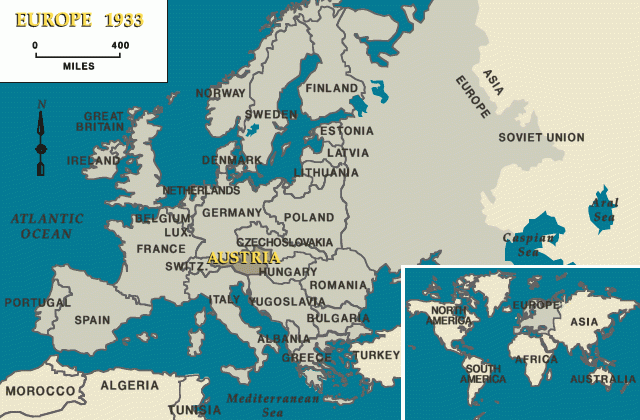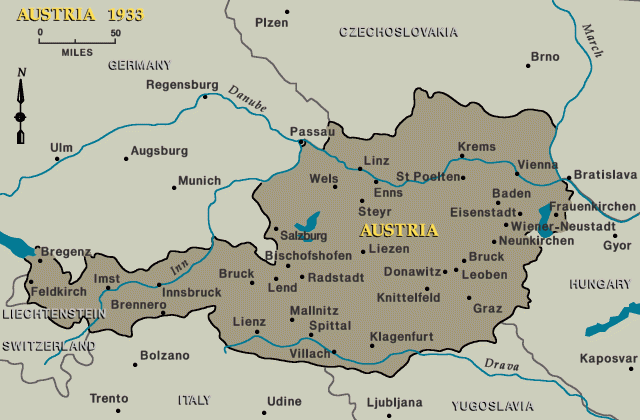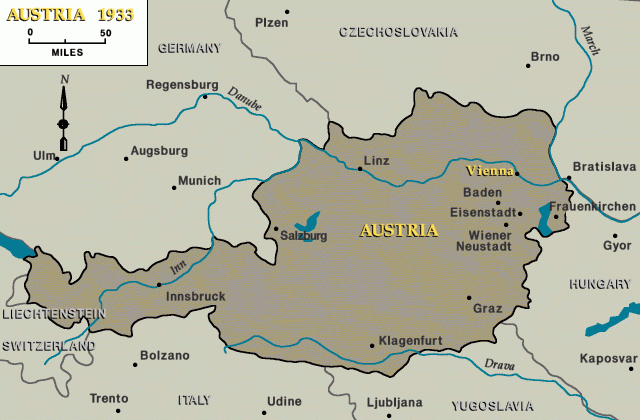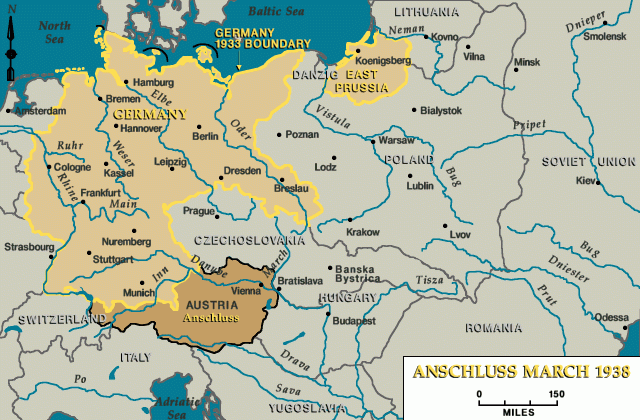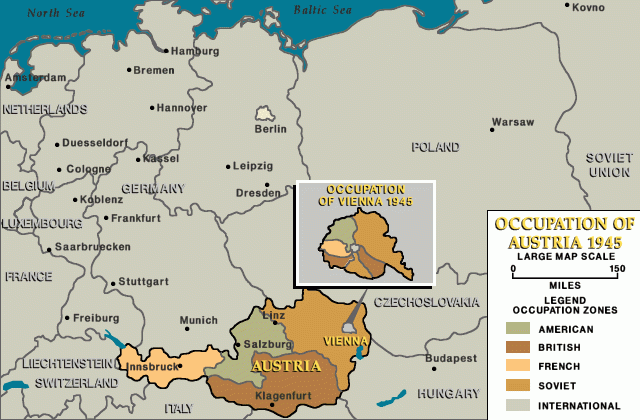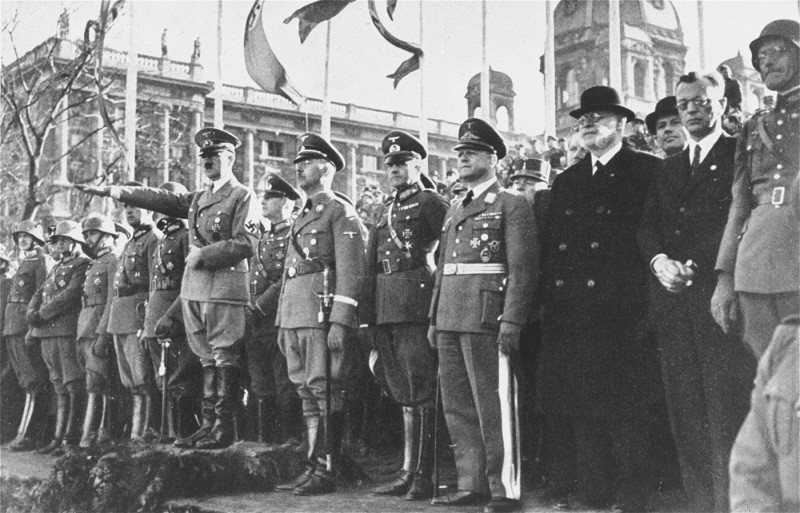
Nazi Territorial Aggression: The Anschluss
Throughout the 1930s, Nazi Germany pursued an aggressive foreign policy. This culminated in World War II, which began in Europe in September 1939. Prewar and wartime territorial expansion eventually brought millions of Jewish people under German control. On March 11–13, 1938, Nazi Germany annexed the neighboring country of Austria. This event is known as the Anschluss.
Key Facts
-
1
The Anschluss was the Nazi German regime’s first act of territorial aggression and expansion.
-
2
The Anschluss was widely popular in both Germany and Austria.
-
3
The Anschluss resulted in an outburst of public violence against Austria’s Jewish population.
On March 11–13, 1938, Nazi Germany annexed the neighboring country of Austria (Österreich). This event is known as the Anschluss. “Anschluss” is a German word that means “connection” or “joining.”
By annexing Austria, the Nazis violated the Treaty of Versailles and the Treaty of Saint-Germain. These treaties expressly forbade the unification of Austria and Germany. The Anschluss demonstrated Nazi disdain for the post-World War I European order. It was the first act of territorial expansion committed by Nazi Germany.
The other European powers did not punish the Nazis for violating international treaties. Their acceptance of the Anschluss was a significant act of appeasement. It allowed Adolf Hitler to continue his expansionary policies unchecked.
The Anschluss transformed Austria. Almost overnight, the country of Austria ceased to exist. In the days, weeks, and months that followed, Austrian and German Nazis carried out the Nazification of all aspects of Austrian life. Many Austrians participated enthusiastically in this endeavor. In the wake of the Anschluss, Austrians persecuted the country’s Jewish population. They enacted Nazi policies. And they fought in World War II. Austrians also participated in the mass murder of Europe’s Jews.
The Anschluss was not inevitable. Nor was the rapid Nazification of Austria. However, certain historical factors and events facilitated these processes.
Ethnic Germans in Austria
Between World War I and World War II, Austria was a country of approximately 6.5 million people. Most of these Austrians considered themselves ethnically German.
At this time, millions of people who considered themselves German lived outside of Germany. Many of them lived in areas that had previously been part of the Austro-Hungarian Empire. Austria-Hungary had collapsed in 1918 at the end of World War I. New states were established in its place. Among them were Austria, Czechoslovakia, and Poland. These countries were home to millions of people who considered themselves German and who spoke German as their primary language.
In the 1920s, many Austrians did not think that their country could survive economically without the lands previously held by Austria-Hungary. Some Austrians hoped to solve this problem by restoring a form of the empire. Others wanted Austria to unite with Germany. The hope of uniting Austria and Germany was not new. Discussions and debates about Austria’s role in a German nation-state dated back to the 19th century.
The peace treaties that ended World War I expressly forbade Germany and Austria from uniting. European leaders worried that a united Germany and Austria would be too large and powerful. Subsequent international financial agreements also required that Austria remain independent from Germany.
Adolf Hitler’s Plans for Austria
Adolf Hitler and the Nazis wanted to redraw the map of post-World War I Europe. Hitler and the Nazis considered the postwar international borders unfair and illegitimate. They claimed that Germans had been denied the right of self-determination. Redrawing Europe’s borders would allow the Nazis to achieve two main goals:
- unite all Germans in a Nazi German empire;
- and acquire Lebensraum (“living space”) in eastern Europe.
The annexation of Austria would help the Nazis achieve the first goal.
Adolf Hitler expressed his desire for an Austro-German union in his earliest writings and speeches. The first point of the Nazi Party Platform (1920) read:
“We demand the union of all Germans in a Greater Germany (Großdeutschland) on the basis of the right of national self-determination.”
Hitler opened his autobiography and political treatise Mein Kampf with his vision for the future relationship between Austria and Germany. He wrote,
“...the reunification [of Germany and Austria] is a life task to be carried out by all means! German-Austria must be restored to the great German Motherland…People of the same blood should be in the same REICH.”
In January 1933, Adolf Hitler was appointed Chancellor of Germany. As chancellor, he fully intended to bring about an Austro-German union. However, Germany was not immediately militarily and diplomatically ready to carry out Hitler’s foreign policy goals. First, Hitler and other Nazi leaders focused on establishing a Nazi dictatorship. Behind the scenes, however, the Nazi leadership began planning territorial expansion and a European war almost as soon as they took power.
The Rise and Impact of the Austrian Nazi Movement
Hitler planned to achieve power in Austria through the Austrian Nazi Party. But, in the late 1920s and early 1930s, the Austrian Nazi Party was weak, divided, and ineffective. Party members disagreed on their relationship to Hitler and their German counterparts. But, by 1931, the bulk of Austrian Nazis recognized Hitler as their leader. Hitler, in turn, appointed a German Nazi to bring the Austrian party in line.
Austrian Nazis gained supporters in 1931–1932 as Hitler’s popularity in Germany increased. This was even more noticeable across Austria after Hitler was appointed German chancellor in January 1933.
For years, Austrian politics had been characterized by infighting and political violence. The rise of the Nazis in 1933 further destabilized the situation. Seizing the moment, Austrian chancellor Engelbert Dollfuss transformed Austria from a democratic republic into a right-wing authoritarian regime under his control. This government is known as the Corporate State (Ständestaat). It is also referred to as the Austrofascist state or the Dollfuss-Schuschnigg regime. Dollfuss’s government was diplomatically aligned with Fascist Italy and authoritarian Hungary.
Like his allies, Chancellor Dollfuss was committed to crushing the political left in Austria. However, Dollfuss and the Austrofascists were not Nazis.
The Nazi Terror Campaign in Austria, 1933
Beginning in May 1933, the Austrian Nazis waged a propaganda and terror campaign. The campaign was encouraged and funded by Germany. The Nazi goal was to undermine the Dollfuss regime by making it look incompetent. They staged disruptive protests and brawled with political opponents and the police. Austrian Nazis set off explosives and tear gas bombs in public places and Jewish-owned businesses.
The Germans claimed that the Austrian government was treating the Austrian Nazis unfairly. In late May 1933, the German government announced an economic sanction against Austria. This sanction was referred to as the “1,000 Mark Sperre.” It required Germans to pay a 1,000 Mark customs fee in order to travel to Austria. This crippled Austria’s tourism industry, which was highly dependent on Germans.
In the face of Nazi terrorism, the Austrian government worked to maintain its power and preserve Austrian sovereignty. In June 1933, in response to a fatal Nazi bombing, the Dollfuss regime banned the Austrian Nazi Party and its affiliates. The Nazi movement became illegal in Austria.
But the Austrian Nazis continued to operate illegally within the country. Many delighted in finding ways to subvert the ban. Additionally, thousands of Austrian Nazis fled across the border into Germany. There, they formed a paramilitary unit known as the Austrian Legion (Österreichische Legion). German Nazis provided the legion with military training. They became a threatening military presence just across the Austro-German border.
The Failed Nazi Coup in Austria, July 1934
On July 25, 1934, Austrian Nazis attempted to overthrow the Austrian government. Members of the Vienna SS took control of the Austrian chancellery, where the cabinet had been meeting. In the process, the conspirators shot and killed Chancellor Dollfuss. Other plotters seized control of the state radio station in Vienna and prematurely announced the coup. Outside Vienna, other Austrian Nazis also revolted against the government.
However, the majority of Austrians remained loyal to the government. The Austrian military and police forces quickly defeated the conspirators. The coup attempt failed. Italian dictator Benito Mussolini sent troops to the Austro-Italian border to defend Austrian sovereignty. Mussolini was friends and allies with Dollfuss and was outraged by the coup attempt and assassination. Austria became a major point of contention between the Italians and Germans.
It is now clear that Hitler ordered the coup, probably sometime in June 1934. Theodor Habicht, the Hitler-appointed leader of the Austrian Nazi movement, planned the putsch alongside Austrian Nazis.
When the coup failed, Hitler denied any involvement. The Nazi regime falsely claimed that this had been a rogue plan carried out by the Austrian Nazi movement. The fallout from the plot made it clear that the Nazis would have to wait to gain control of Austria. They were willing to take things more slowly in exchange for a successful outcome.
After Dollfuss’s death, Kurt von Schuschnigg took over as Austrian chancellor and dictator. He continued many of his predecessor’s authoritarian policies. The Austrian government arrested thousands of Austrian Nazis, including a number of the conspirators.
Austria’s Diplomatic Isolation
In the aftermath of the failed coup, Austro-German relations were a source of international concern. This was particularly true for Italy’s Mussolini, who initally treated Austria as a buffer between Italy and Nazi Germany. But Fascist Italy and Nazi Germany began to draw closer together in 1935–1936. Mussolini began to pressure Schuschnigg to cooperate with the Germans.
By winter 1937–1938, Austria found itself diplomatically isolated and facing an increasingly aggressive Nazi Germany. The international community showed little interest in maintaining Austrian independence. By that point, both the French and the British had accepted an Austro-German union as inevitable. The Dollfuss regime’s brutal repression of Austrian Social Democrats in February 1934 had not won them many friends in countries like Britain and France. Even Mussolini was no longer a reliable guarantor of Austrian independence.
The Beginning of the End: The Berchtesgaden Agreement, February 1938
On February 12, 1938, Austrian chancellor Schuschnigg traveled to meet with Hitler. Schuschnigg expected to discuss the tensions between Austria and Germany. But Hitler was ready to take full control of Austria. He made a series of demands that included the following:
- Austria’s foreign and military policies were to be coordinated with Germany’s;
- Austrian Nazi Arthur Seyss-Inquart was to be placed in charge of policing and security matters;
- Austrian Nazis who had been imprisoned by the Austrian government were to be amnestied.
Hitler used the presence of several German generals to intimidate Schuschnigg. Schuschnigg gave in and signed the agreement. Named after the town where it was signed, this agreement is known as the Berchtesgaden Agreement. It undermined Austrian sovereignty and independence.
A Final Attempt at Asserting Austrian Independence
On March 9, Austrian chancellor Schuschnigg attempted to assert Austrian independence one last time. He called a plebiscite (referendum). The plebiscite was scheduled for Sunday, March 13, 1938.
The referendum asked voters to support or reject the following call for Austrian independence:
“For a free and German, independent and social, for a Christian and united Austria! For peace and work and the equality of all who profess the Volk and Fatherland.”
The next day, propaganda urging voters to support Austrian independence appeared everywhere. It was even painted on the streets and sidewalks. Schuschnigg hoped that the plebiscite would show the international community that Austrians wanted to remain independent. He predicted that the results would be 65% in favor of independence and 35% against.
Hitler was infuriated by the plebiscite and decided to take action.
Timeline: The Anschluss, March 11–13, 1938
The Anschluss took place over three days in March 1938. Even though the Nazi threat to Austria had been clear for years, people were still surprised and caught off guard.
Friday, March 11, 1938
On March 11, Hitler gave the Austrian government a series of ultimatums:
- Chancellor Schuschnigg must call off the plebiscite;
- Schuschnigg must resign as chancellor;
- Austrian president Wilhelm Miklas must appoint Austrian Nazi Arthur Seyss-Inquart as the new Austrian chancellor.
If these demands were not met, the German military would invade Austria. Schuschnigg gave in. That evening, Austrian radio announced the cancellation of the upcoming plebiscite on Austrian independence.
Shortly thereafter, at 7:47 pm, Chancellor Schuschnigg gave a radio address that was broadcast throughout Austria. He announced his resignation in the face of German pressure. Schuschnigg instructed Austrians and the Austrian military not to resist German troops if they invaded. He was unwilling to fight a war or spill blood for Austrian independence.
Within minutes of Schuschnigg’s resignation, swastika armbands and flags appeared on the streets. Austrian Nazis now had license to attack their political opponents and Jews without fear of repercussions. They seized power in government buildings and dominated the streets with torchlight parades, chants, and salutes to Hitler.
Austrian Nazis took over the country without firing a single shot.
Terrified Jews, leftists and Schuschnigg supporters tried to flee Austria. They raced towards the country’s borders, hoping to reach them before they were closed. Some managed to escape, but most were trapped in a rapidly Nazifiying Austria. Schuschnigg remained in Vienna, where he was placed under house arrest.
Saturday, March 12, 1938
Just after midnight on March 12, Austrian president Wilhelm Miklas reluctantly gave into the last of Hitler’s demands. He appointed Seyss-Inquart as chancellor of Austria. In turn, Seyss-Inquart announced a new cabinet filled with Austrian Nazis. This was a domestic change of power brought on by external pressure from Nazi Germany. But that was not enough for Hitler.
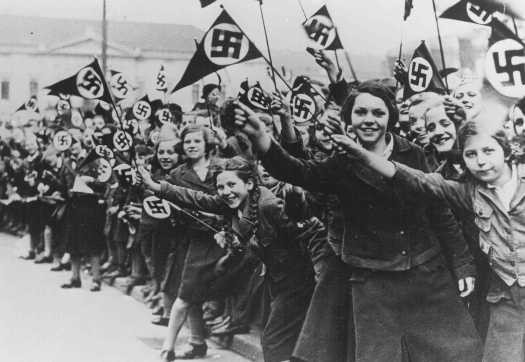
Despite the fact that the Austrians had given in to all of Hitler’s demands, German troops crossed the border early in the morning at around 5 am. They were not met with armed resistance, but with cheers and flowers. Austrians welcomed Hitler warmly as he traveled first to Linz and then on to Vienna.
Sunday, March 13, 1938
On March 13, Austrian Nazi Chancellor Seyss-Inquart signed the law called the “Reunification of Austria with Germany” (“Wiedervereinigung Österreichs mit dem Deutschen Reich”).
The word “reunification” was a misnomer. Austria had never been a part of the German Empire. This law, sometimes called the Anschluss law, formally incorporated Austria into Nazi Germany. It gave the Anschluss the air of legality.
Austria was no longer an independent country. It was now a province (Land) of Nazi Germany. The Nazis wanted to get rid of any traces of a separate Austrian identity. In Nazi Germany, Austria was initially referred to by a new name: the Ostmark. In the German language, Austria was (and is) called Österreich, meaning “eastern empire.” By changing the name, the Nazis demoted Austria from empire to province. Subsequent administrative reorganizations resulted in more name and border changes. In 1942, the Nazi regime officially referred to the area as the Alpine and Danubian Districts (Alpen- und Donau-Reichsgaue).
The law also mandated a new plebiscite on the issue of Austrian unification with Nazi Germany. This new plebiscite was scheduled for April 10.
Antisemitic Violence during the Anschluss
For Austria’s approximately 200,000 Jews, the Anschluss marked a terrible turning point.
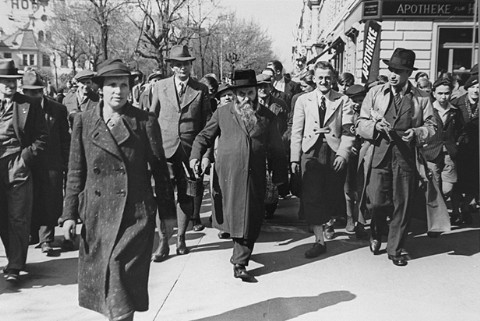
Beginning on the night of March 11 and in the weeks that followed, there was pogrom-like violence across the country. Austrian Nazis and others beat up, attacked, and humiliated Jews. They forced Jews to clean public toilets and perform humiliating exercises. They especially targeted religious Jews. So-called “scrubbing parties” (“Reibpartien”) were the most notorious. Nazis forced Vienna’s Jews to scrub the city’s streets while jeering crowds mocked them. In particular, they forced them to remove the pro-independence political slogans from the canceled Schuschnigg plebiscite.
Soon, Austria’s Jews were subjected to the laws and restrictions that discriminated against Jews in Nazi Germany. Many decided to try to leave Austria. Lines appeared at consulates across the city of Vienna.
Nazi Propaganda and the Anschluss
The Nazis celebrated the Anschluss as the fulfillment of the German people’s destiny. They glorified it in speeches and propaganda events.
Most famously, on March 15, Hitler spoke to a huge crowd in Vienna’s Heldenplatz, a large square in the center of Vienna. In his speech, he celebrated Nazi Germany’s annexation of Austria. Film footage and photographs of the crowds appeared in German newsreels and newspapers. Their goal was to demonstrate Austrian enthusiasm for the Anschluss and thus justify the illegal takeover of another country. When Hitler returned home to Berlin, he was greeted as a hero.
The April 10 plebiscite was another propaganda opportunity. The Nazi propaganda offensive in support of the vote coopted and mobilized a wide variety of Austrian institutions and leaders. These included representatives of two constituencies that had been reluctant to embrace the Nazi movement: the Austrian working class and the Catholic Church. The result of the referendum seemed to indicate that around 99 percent of the Austrian people wanted to unite with Nazi Germany. However, between 300,000 and 400,000 Austrian citizens were forbidden to vote in the referendum. Among those excluded were Austrian Jews, Roma, and the Nazis’ political opponents.
Embracing the Anschluss in Austria
Many Austrians helped carry out the Nazification of their country. Austrian civil servants, soldiers, and police officers took a new oath to Adolf Hitler. They did this in public celebrations, often accompanied by parades. A variety of organizations and institutions adopted Nazi ideas and implemented Nazi policies. Many expelled their Jewish members and fired their Jewish employees.
Communists and Social Democrats, the political groups most likely to resist the Nazis, had already been crushed by the Dollfuss-Schuschnigg regime. Many members of these movements were already living in exile. Those Nazi opponents who remained in Austria faced the full wrath of the Nazi SS and police system. The Nazis quickly established Gestapo offices in Austria to hunt down political opponents.
The Anschluss as the First Step in Hitler’s Takeover of Europe
The Anschluss was the Nazi regime’s first act of territorial aggression and expansion. It was a watershed moment in Nazi Germany’s foreign policy. The international community did not intervene to try and stop the Anschluss. Nor did they punish Nazi Germany for violating international treaties. Thus, the Anschluss is one of the earliest and most significant examples of the international community’s appeasement of Adolf Hitler’s aggressive foreign policy.
The German annexation of Austria marked a significant breach of the post-World War I international order. Just six months later, Nazi Germany manufactured a crisis in the Sudetenland, a region of Czechoslovakia. In September 1938, world leaders from Italy, France, and Great Britain met with Hitler in Munich to discuss the issue. They appeased Hitler by ceding the region to Nazi Germany. They did so on the condition that the rest of Czechoslovakia remained off limits.
In March 1939, Nazi Germany broke this agreement and occupied the Czech lands, including Prague. And, in September 1939, Nazi Germany invaded Poland, an act of territorial aggression and expansion that started World War II.
Footnotes
-
Footnote reference1.
The Austro-Hungarian Empire was also known as the Habsburg Empire (after the imperial family). It governed territory well beyond the borders of today’s Austria. This empire was home to millions of Germans, as well as other nationalities, including Croats, Czechs, Hungarians, Italians, Poles, Slovaks, Slovenes, Ukrainians, and many others.
Critical Thinking Questions
- How did the Anschluss fit into the Nazis’ views on territorial expansion and race?
- What was the range of responses that Austrians had to the Anschluss? Why?
- What could the international community have done to stop the rise of Nazism in Europe?


